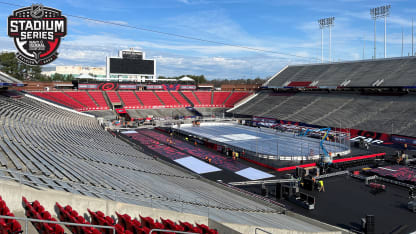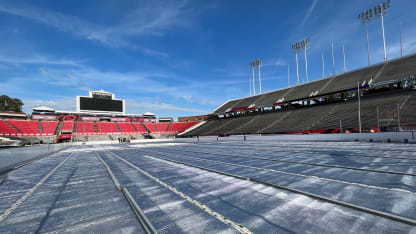The ice was covered with tarps Wednesday, as the sun shone brightly at times and the temperature rose to 72 degrees Fahrenheit. The forecast calls for clouds and a high of 73 on Thursday, then rain and a high of 65 on Friday.
But the NHL is well prepared to stage its first outdoor game in North Carolina, and it should be dry and about 40 degrees at face-off (8 p.m. ET; ABC, ESPN+, SN360, TVAS2). The game was scheduled at night by design.
RELATED: [Complete NHL Stadium Series coverage | 2023 Stadium Series rendering]
"Everything's working as it should, and we're in good shape," said Derek King, NHL senior director of facilities operations and hockey operations. "You look at the weather app, and it's changing all the time. We have a plan."
This will be the 37th outdoor game the NHL has staged since 2003. The League has dealt with all kinds of conditions in all kinds of places -- from minus-6 degrees to 65 degrees at face-off; from sun to wind to rain; from Edmonton to Winnipeg to Nashville to Dallas -- and it has learned from each experience.
The NHL first used tarps to protect the ice during the day when the Los Angeles Kings hosted the Anaheim Ducks in the Stadium Series at Dodger Stadium on Jan. 25, 2014. That was the first NHL outdoor game in a warm-weather venue, and it was played at night. The temperature reached 77 that day, but it was down to 62 at face-off.
The tarps are silver on the surface to reflect sunlight. They insulate the ice, keeping it cold the way a pool cover keeps water warm. King said it was 85 degrees on top of the tarps as the sun heated them Wednesday, but it was 18 degrees underneath them.
"They work, and that's why we use them," King said.
Walking around the perimeter of rink, you could hear a sound similar to bubbling water. But it wasn't the ice melting, but rather glycol pumping through aluminum pans underneath the ice, withdrawing heat to be expelled by the Mobile Refrigeration Unit, a trailer outside the stadium with the same ice plant you would find in an indoor NHL rink.



















